Thank you for visiting Travel is Life! I'm going to show you today exactly how I built this website including all the tools, themes, plugins, services, and customizations I use to power the backend and frontend of the site. This information will change over time because I am constantly developing this site, adding new features, and making improvements. I will keep this post up-to-date with new developments. If you have any questions about anything mentioned here, leave a comment and I'll get back to you as quickly as I can.
Why is this information important?
I spend a lot of time and energy researching the tools and processes I employ to power this website. I've been developing websites for over 10 years, and there's one big lesson I've learned which is: Do it right the first time. That lesson will save you a lot of headache if you follow it blindly. I'm hoping you can benefit from my experience. You might find the information on this page especially helpful if:
- You run your own travel blog. I may do things here that you like and want to implement on your own site. Or maybe you do things better. If so, tell me in the comments.
- You're starting a new travel blog. Do it right the first time! Not everything I do here for Travel is Life will be right for your site – we all have different needs – but you can use this as a starting point for building your own development plan.
- You're starting any kind of blog or website. Even if you're not starting a travel blog, the information on this page is valuable regardless of your blog's subject matter. There's a lot of overlap in the processes I use to build all of my sites.
I have a lot of information to cover, so I'm going to focus on the What and the Why and not on the How unless you ask me specific questions in the comments. Most of the tools I mention come with extensive documentation and developer support that you can reference for the How.
Let's get started…
Here's a snapshot of the tools mentioned on this page.
I go into detail about each tool down below. You can scroll past this summary section if you'd like.
| Category | Tool |
|---|---|
| CMS | WordPress.org |
| Website Host | WP Engine |
| SSL Certificate | Let's Encrypt |
| Offsite Backups | ManageWP / VaultPress |
| Malware & Security | WP Engine / Sucuri |
| Spam Prevention | Akismet |
| Content Distribution | Cloudflare |
| Themes | Extra / Divi |
| Child Theme Maker | Elegant Marketplace |
| Divi Enhancement Suite | Divi Booster |
| Hosted E-Commerce | Shopify |
| WordPress E-Commerce | WooCommerce |
| WooCommerce Plugins | WC External Product New Tab / WooSidebars |
| SEO Plugin | Yoast SEO |
| Traffic & Analytics | Google Analytics |
| Webmaster Tools | Google / Bing / Yandex |
| Privacy Policy Generator | FreePrivacyPolicy.com |
| TOS Generator | GetTerms.io |
| Free Commercial Images | Unsplash / Realistic Shots / Travel Coffee Book / Pixabay / Creative Commons / Google Images |
| Forms Builder | Gravity Forms |
| E-mail Marketing | MailChimp / Aweber |
| OAuth Login | WP Social Login |
| MailChimp Plugin | MailChimp for WordPress |
| Avatars | WP User Avatar |
| Login Image | Custom Login Image |
| E-mail Capture | Bloom |
| Travel is Life Social | Instagram / Facebook / Twitter / Google+ / Tumblr / Pinterest / StumbleUpon |
| Travel is Life Video | YouTube / Vimeo |
Which content management system do you use to power your travel blog?
 Well, obviously WordPress.org which is the free self-hosted version of WordPress.com blogging platform. I say “obviously” because there's no alternative. If you're looking to build your blog into a business or income producing website, you need to be using WordPress if you're not already. If you're on Squarespace or Blogger or even WordPress.com, you need to switch to your own hosted domain and install WordPress(.org). I'm assuming you're already educated about why you need to be on WordPress and will gloss over this section.
Well, obviously WordPress.org which is the free self-hosted version of WordPress.com blogging platform. I say “obviously” because there's no alternative. If you're looking to build your blog into a business or income producing website, you need to be using WordPress if you're not already. If you're on Squarespace or Blogger or even WordPress.com, you need to switch to your own hosted domain and install WordPress(.org). I'm assuming you're already educated about why you need to be on WordPress and will gloss over this section.
Which website host is best for my travel blog?
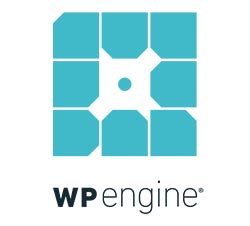 I use WP Engine to host Travel is Life. I also use WP Engine to power many client sites and other projects and can vouch for their service and support. This link is my affiliate link and will take 20% off your first payment. I send a lot of business their way because they've earned my loyalty.
I use WP Engine to host Travel is Life. I also use WP Engine to power many client sites and other projects and can vouch for their service and support. This link is my affiliate link and will take 20% off your first payment. I send a lot of business their way because they've earned my loyalty.
My host is crucial to the success of this blog. My host is (partially) responsible for the security of the site, the speed in which it loads, and the site's consistent uptime. If those three factors were to fail I'd be out of business.
For less important websites, I can get by with cheaper hosting. For sites that matter and that earn an income – only a premium option like WP Engine will suffice. I can't stress enough the importance of a reliable and secure host. Do it right the first time. You don't upgrade to a premium host when your site starts making money – you start with or upgrade to a premium host so your site starts making money. This is the only thing I'm going to actively sell you on today. Upgrade your host. WP Engine will transfer your site over for free. If you use my affiliate link to sign up (and save 20%), I'll even transfer your site over for you. E-mail [email protected]. Moving on…
Which SSL Certificate do you use to secure your website with HTTPS?
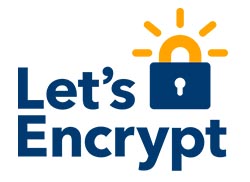 An SSL Certficiate is what puts the HTTPS in front of your website's URL. It means that all data sent between your website and your visitors' browsers is encrypted. If you do e-commerce on your website, it's mandatory. If you collect visitor information on your website, it's mandatory. An SSL certificate helps protect the privacy of your visitors by securing their information during transmission. Lastly, it'll help your search engine ranking as it's now a factor in Google's algorithm for determining your search rank.
An SSL Certficiate is what puts the HTTPS in front of your website's URL. It means that all data sent between your website and your visitors' browsers is encrypted. If you do e-commerce on your website, it's mandatory. If you collect visitor information on your website, it's mandatory. An SSL certificate helps protect the privacy of your visitors by securing their information during transmission. Lastly, it'll help your search engine ranking as it's now a factor in Google's algorithm for determining your search rank.
I use Let's Encrypt which is a free, automated, and open Certificate Authority sponsored by companies like Facebook, Mozilla, Shopify, and many others. In the past I've paid upwards of $99/year for SSL Certificates and now I exclusively use Let's Encrypt on my sites. It'll satisfy the needs of your blog or e-commerce website. WP Engine has a one-click installation option for adding your SSL Certificate by Let's Encrypt and so do many other hosts. Be sure to redirect your HTTP traffic to your new HTTPS URLs and update your sitemaps in Google and Bing Webmasters after you install the SSL Certificate.
How else do you secure your travel blog?
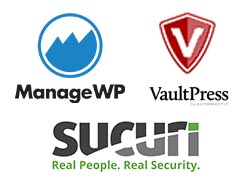 On many websites, I use an offsite backup service like ManageWP or Vaultpress. I also use Sucuri on a lot of sites to protection them against hackers and malware. But I don't need them for Travel is Life because WP Engine includes daily backups, built-in firewall, and virus/malware protection. I only mention those services now because if you're on a shared host like Bluehost or Dreamhost, you'll want to use at least one or two of those services to protect your site. Or just switch to WP Engine.
On many websites, I use an offsite backup service like ManageWP or Vaultpress. I also use Sucuri on a lot of sites to protection them against hackers and malware. But I don't need them for Travel is Life because WP Engine includes daily backups, built-in firewall, and virus/malware protection. I only mention those services now because if you're on a shared host like Bluehost or Dreamhost, you'll want to use at least one or two of those services to protect your site. Or just switch to WP Engine.
 For Travel is Life, I use a couple other services that aren't built-in to WP Engine. To help prevent Spam in my comments and submission forms, I subscribe to Akismet. They are my first line of defense against Spam comments. Some spam still gets through but no spam prevention service is perfect. Akismet has stopped millions of spam comments between all my sites at this point. Yeah seriously – millions! Spam is a big problem with websites.
For Travel is Life, I use a couple other services that aren't built-in to WP Engine. To help prevent Spam in my comments and submission forms, I subscribe to Akismet. They are my first line of defense against Spam comments. Some spam still gets through but no spam prevention service is perfect. Akismet has stopped millions of spam comments between all my sites at this point. Yeah seriously – millions! Spam is a big problem with websites.
 In combination with WP Engine's built-in security measures and Akismet's spam prevention, I subscribe to a service called Cloudflare. This gets a bit technical, but in a nutshell Cloudflare performs two major functions for me:
In combination with WP Engine's built-in security measures and Akismet's spam prevention, I subscribe to a service called Cloudflare. This gets a bit technical, but in a nutshell Cloudflare performs two major functions for me:
1) Their Content Distribution Network (CDN) caches (stores) a copy of my website on hundreds of servers across their global network. This makes my website load faster for international visitors because they are loading my site from Cloudflare's closest regional server instead of loading it from the USA where WPEngine servers are located. That makes sense, right? The less distance data has to travel, the faster it gets there.
2) Cloudflare also provides DDoS Protection against Denial-of-service (DoS) attacks which are a worldwide problem. A DDoS attack is when hundreds of thousands of infected computers around the world attack (or repeatedly access) a server in order to shut it down. Cloudflare recognizes these kinds of attacks and diverts the “bad” traffic away from your website and only filters through the “good” traffic.
Why would someone attack your site like that? Well, often times it's not necessarily YOUR site that's being attacked, but a website on the same server, or the entire server itself. So that's why I have Cloudflare. I need my site online at all times because Uptime = Positive Experience for Visitors = Income.
Which WordPress theme is best for my travel blog?
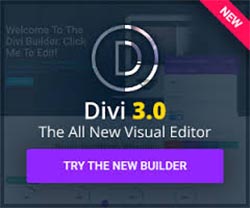 Currently I'm using Extra by Elegant Themes in combination with a custom child theme. Extra is almost identical to their well-known Divi theme but with a different look. I started using Divi on some client sites a few years ago because the clients wanted to manage the website themselves. Divi/Extra themes are relatively codeless options for creating visually appealing websites so it was a good option for them. Since then I've fallen in love with the theme and use it on a lot of my personal projects too. Even though I can code, the ability to do some advanced things without code saves me a lot of time.
Currently I'm using Extra by Elegant Themes in combination with a custom child theme. Extra is almost identical to their well-known Divi theme but with a different look. I started using Divi on some client sites a few years ago because the clients wanted to manage the website themselves. Divi/Extra themes are relatively codeless options for creating visually appealing websites so it was a good option for them. Since then I've fallen in love with the theme and use it on a lot of my personal projects too. Even though I can code, the ability to do some advanced things without code saves me a lot of time.
Other than customization, their themes have proven to be secure and reliable and receive regular updates. In terms of doing it right the first time, I'm careful which developer baskets I put my eggs into. I need a solution that is steadily updated and comes with reliable developer support. For me, Elegant Themes has earned my loyalty in those regards.
One last plus of the theme is the large community of Divi/Extra users which makes life easier when searching for solutions for advanced customizations. Chances are, someone, somewhere, in the Divi community has done it and published a tutorial on it. The ability to self-troubleshoot problems via a large community of users is a big plus when choosing a theme. That's ultimately why I decided to use Extra to power my site.
Using a child theme alongside Extra lets me customize the theme files and still receive updates from Elegant Themes without losing my customizations. I used the tool Child Theme Maker by ElegantMarketplace.com to create the foundation for my child theme and have then added to it.
What do you use to power your e-commerce shop?
 First, let me clarify that at the moment, I don't technically have an e-commerce shop, which means I don't process any sales on Travel is Life. Instead, I have an affiliate shop which links visitors to sites like Amazon, Etsy, or a number of other partner sites who handle the transaction on their end.
First, let me clarify that at the moment, I don't technically have an e-commerce shop, which means I don't process any sales on Travel is Life. Instead, I have an affiliate shop which links visitors to sites like Amazon, Etsy, or a number of other partner sites who handle the transaction on their end.
Prior to the launch of the new Travel is Life site in January 2017, I had an actual e-commerce shop hosted on Shopify that sold t-shirts. When I launched the new version of the website, I took all the Travel is Life T-Shirts and put them onto the SunFrog Marketplace to process the transactions. SunFrog was already my printing partner via their wholesale site MerchPond.com so it was a relatively easy transition. The shirts are still designed and sold by me, but the transaction itself happens off my site.
 Now to power the shop, I use WooCommerce which is an Automattic company (the people behind WordPress). This plugin allows me to add products as a custom post type to my WordPress site, view them in a filterable grid, and also provides special widgets for the shop area of the site. It's similar to how a typical online store functions except I don't have a Cart or Checkout page at Travel is Life. Instead, the Buy Now buttons leads visitors offsite to a partner store that handles the transaction.
Now to power the shop, I use WooCommerce which is an Automattic company (the people behind WordPress). This plugin allows me to add products as a custom post type to my WordPress site, view them in a filterable grid, and also provides special widgets for the shop area of the site. It's similar to how a typical online store functions except I don't have a Cart or Checkout page at Travel is Life. Instead, the Buy Now buttons leads visitors offsite to a partner store that handles the transaction.
When visitors click on a Buy Now button and leave my site, I open the affiliate links in a new window so that they can easily return to my site and continue browsing. Opening links in a new window is not default with WooCommerce, so I use the plugin WC External Product New Tab by Stuart Duff which works perfectly.
One other plugin I use is WooSidebars which I use to build separate sidebars for the Shop than for the rest of the website. For example, on my Shop pages, I like things like Product Categories or Recently Viewed Products visible on the sidebar, but that wouldn't make sense to have visible on the rest of the website.
How do you optimize your travel blog for search engines?
Well there's a big question! How much time do you have? 🙂
While I can't teach you everything I've ever learned about SEO in the past 13 years, I will show you which tools and services I use on Travel is Life. Remember, this post is about the What and the Why and less about the How which I'll have to save for another day.
Yoast SEO
 To manage my site's meta info like meta-title and meta-description, I use Yoast SEO Plugin. Many themes, including Divi/Extra, have built-in functionality for those things, but I prefer to separate them into a plugin so that I retain my meta info in the event that I switch themes, which is likely. It won't be long before I require a custom theme (due to some upcoming new features at Travel is Life), so housing my SEO meta info into a plugin will make for an easy transition. I use Yoast SEO on most of my WordPress websites.
To manage my site's meta info like meta-title and meta-description, I use Yoast SEO Plugin. Many themes, including Divi/Extra, have built-in functionality for those things, but I prefer to separate them into a plugin so that I retain my meta info in the event that I switch themes, which is likely. It won't be long before I require a custom theme (due to some upcoming new features at Travel is Life), so housing my SEO meta info into a plugin will make for an easy transition. I use Yoast SEO on most of my WordPress websites.
Other than storing the meta info, Yoast SEO has some advanced tools to help craft titles and descriptions, and some social tools that come in handy. For example, I use Yoast SEO to set a default image to share on social media for posts that don't have a featured image. The plugin also automatically creates my sitemaps for pages, posts, products, and custom post types. And I use it to remove the “/category/” descriptor from my URLS so that they are shorter, which is something I prefer. So for example the “Travel Quotes” category of my blog is located at https://travelislife.org/travel-quotes instead of htts://travelislife.org/category/travel-quotes – which I think is better.
In the past I've had to use multiple plugins or PHP customizations to handle these things, so I'm pleased with being able to use Yoast SEO as an all-in-one solution.
WordPress Settings –> Permalinks
WordPress gives me a few options for how my URLs are displayed, like whether or not to include the date or category in between the post name.
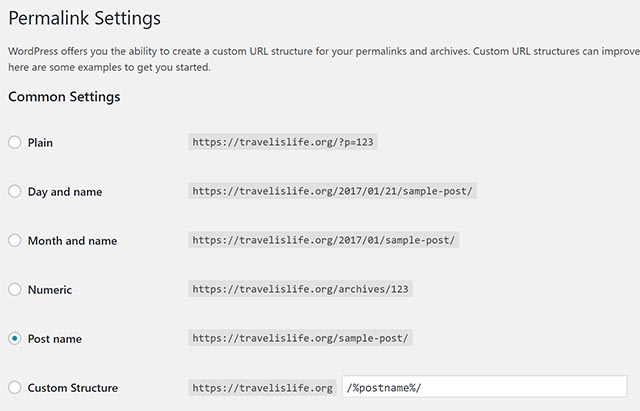
I always choose the Post Name option for a few reasons:
- It keeps my URLs shorter which is easier for visitors to read.
- It adds less clutter to my URLs so I can focus on the important keywords, which is easier for Google to read.
- Without the date included in the URL, I can update and revamp old posts to make them new again, without the original date as a dead give away.
- I just like it that way. I'm a minimalist.
There are reasons for including the date or the category in your post, like if your site is updated so often about similar topics, that you'd run out of slugs to use. For example, if your blog is about Apple products and you often have a post entitled “iPhone Updates” it may make sense to include the date in your URLs for added clarity.
There is never a reason in my opinion to use the default Plain permalink setting. At minimum, change that immediately to the Post Name option. All your old links will still work.
Important Note: If you change your permalink settings away from including the category or date, you may need to 301-redirect your old permalinks to your new shorter links. This will retain your current search engine placement and prevent any broken links from appearing on the web or social media.
Analytics
 For right now, I only use Google Analytics on my website to track visitors and acquisition data. Down the road, there are some advanced tracking tools that I may implement, but at a minimum, I will always have Google Analytics. I prefer to use an outside tool for analytics tracking, as opposed to a plugin or any built-in theme stats or host analytics so that I have the freedom to re-do everything about my site (like host, theme, plugins, etc) and still retain the visitor data.
For right now, I only use Google Analytics on my website to track visitors and acquisition data. Down the road, there are some advanced tracking tools that I may implement, but at a minimum, I will always have Google Analytics. I prefer to use an outside tool for analytics tracking, as opposed to a plugin or any built-in theme stats or host analytics so that I have the freedom to re-do everything about my site (like host, theme, plugins, etc) and still retain the visitor data.
Webmasters
 One of the best ways to learn about how your site is seen by search engines is to install their webmaster tools. For many people, Google Webmasters may be enough, but I go a bit farther and register with a few more. Often times, people talk about search engine optimization and Google optimization as if they're the same thing. And while they're similar, and optimizing your site for Google will for the most part satisfy the requirements of other search engines, I like to know how I'm doing with Microsoft Bing and other smaller search engines. Here's my list of webmaster services that I use currently:
One of the best ways to learn about how your site is seen by search engines is to install their webmaster tools. For many people, Google Webmasters may be enough, but I go a bit farther and register with a few more. Often times, people talk about search engine optimization and Google optimization as if they're the same thing. And while they're similar, and optimizing your site for Google will for the most part satisfy the requirements of other search engines, I like to know how I'm doing with Microsoft Bing and other smaller search engines. Here's my list of webmaster services that I use currently:
- Google Webmasters – https://google.com/webmasters
- Bing Webmasters – https://bing.com/toolbox/webmaster
- Yandex Webmasters – https://webmaster.yandex.com
I wish I could use Baidu Webmaster Tools, but as far as I know they aren't available in English.
How did you create your Privacy Policy and Terms of Service pages?
 Do you display your Privacy Policy and Terms of Service on every page of your website? Do you have a privacy policy or terms of service visible on your site? If not, you should. In fact, it's required by some advertising platforms, some of which automatically scan your landing pages to check for these pages before approving your account or your ads. It's also important for building trust and rapport with your visitors. Most people will never read it, but it's nice for them to see that you have one. It may save your butt one day too – but hopefully you and I will never run into any problems relating to privacy or data use on our blogs.
Do you display your Privacy Policy and Terms of Service on every page of your website? Do you have a privacy policy or terms of service visible on your site? If not, you should. In fact, it's required by some advertising platforms, some of which automatically scan your landing pages to check for these pages before approving your account or your ads. It's also important for building trust and rapport with your visitors. Most people will never read it, but it's nice for them to see that you have one. It may save your butt one day too – but hopefully you and I will never run into any problems relating to privacy or data use on our blogs.
For my Privacy Policy, I used FreePrivacyPolicy.com to generate a template that I created by filling in the blanks via options on their site.
For my Terms of Service, I did the same thing using GetTerms.io.
I'm not affiliated with either of those websites, and I can't vouch for whether or not using their services will protect you legally or open you up to legal problems. For now, they were my best options for satisfying the requirements of the ad platforms I use. In the future, I'll consult an attorney proficient in these matters to revise these pages, and I recommend you do the same. This isn't legal advice. But you already knew that.
Where do you get your images from? And what's the deal with your DMCA Policy?
 Most of the images I use on Travel is Life are mine, so I'm not worried about anyone complaining at me for using copyright images. However, I also use a mixture of images that I've gotten permission from the photographers to use, and Creative Commons Zero images that are labeled for free commercial use. Here are a few websites where you can download some amazing travel photos to use on your blog:
Most of the images I use on Travel is Life are mine, so I'm not worried about anyone complaining at me for using copyright images. However, I also use a mixture of images that I've gotten permission from the photographers to use, and Creative Commons Zero images that are labeled for free commercial use. Here are a few websites where you can download some amazing travel photos to use on your blog:
- Unsplash – My favorite source of amazingly beautiful free images. It's so good, I almost hate to tell you about it! But I'm all about spreading the love.
- Realistic Shots – They add 7 new photographs a week and a lot of them are great for travel blogs.
- Travel Coffee Book – A great site that is only focused on providing travel images, so it's fun to browse through.
- Pixabay – Lots of non-travel photos too, but they have over 850,000 free high resolution photos, so there's something for everyone if you take the time to search or scroll through.
- Creative Commons Search – This website searches multiple image databases for free commercial use images. The results aren't always great, but you can get specific with your searches which is helpful sometimes.
- Google Images – Let's not forget that you can use the Tools –> Usage Rights option to filter your image search by license type, including “Labeled for reuse”.
See Also: 10 Best Sites To Find Free Travel Photos for Your Travel Blog
Even though I go through proper channels to obtain images that I'm allowed to use on Travel is Life, there's always the possibility of an image slipping by me, and that's why I post a DMCA Policy. DMCA stands for “Digital Millennium Copyright Act” and is a U.S. copyright law that addresses the rights of owners of copyrighted material. Essentially my DMCA Policy provides instructions on how to submit a request if you think that I'm using one of your copyright images on my website, and how I handle those requests. I can't imagine this ever been an issue on this website, but just in case, I'm prepared.
I drafted my own DMCA Policy by piecing together other templates and examples I found online. In reality, if someone says I'm using their copyrighted work, I'll probably just remove the image and replace it with another one. I respect the work of others. And why argue when free images are abundant online? In 13 years, in all my sites, I've only run into this once. I received a formal letter, removed the image, and that was that.
How did you create your Travel is Life Guestbook?
 Now we're getting into the good stuff! This is a section that I am excited to share with you. I created a Travel is Life Guestbook so that I could see who's visiting me from all over the world in one central place. Even though you can leave a comment on any blog post here, I wanted an area for travelers to say hello or say something unrelated to a particular post.
Now we're getting into the good stuff! This is a section that I am excited to share with you. I created a Travel is Life Guestbook so that I could see who's visiting me from all over the world in one central place. Even though you can leave a comment on any blog post here, I wanted an area for travelers to say hello or say something unrelated to a particular post.
Which by the way, if you haven't already, please stop by and sign the Travel is Life Guestbook. That link will open in a new window so you can save your place on this page.
It's okay.. take your time. I'll wait.
Okay, all set? Let's continue.
To create the guestbook I wanted, I needed a five step process:
- Visitor fills out the form on the guestbook page.
- Website receives the information and filters out any spam submissions.
- Website automatically creates a blog post using the user submitted info.
- I receive this as a Pending Post that I can publish or discard.
- After I Publish the submission, it appears in my Guestbook on the frontend of the site.
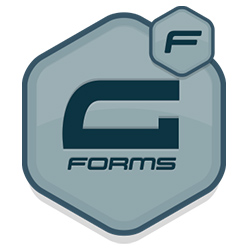 First I used Gravity Forms plugin to create the actual submission form on the guestbook page. I absolutely love Gravity Forms and I use the software on every website from basic contact forms to powering job application forms. It's extremely versatile and very easy to use with drag and drop form creators. I've never found any WordPress form plugins better than Gravity Forms in all my years of searching so I recommend it often. I actually have an entire website dedicated to Gravity Forms called GravityExamples.com where I publish pre-made Gravity Form templates. Anyway, you get the gist – I'm a big fan.
First I used Gravity Forms plugin to create the actual submission form on the guestbook page. I absolutely love Gravity Forms and I use the software on every website from basic contact forms to powering job application forms. It's extremely versatile and very easy to use with drag and drop form creators. I've never found any WordPress form plugins better than Gravity Forms in all my years of searching so I recommend it often. I actually have an entire website dedicated to Gravity Forms called GravityExamples.com where I publish pre-made Gravity Form templates. Anyway, you get the gist – I'm a big fan.
To make the form and program it to automatically create posts from the user submitted content, I followed these directions provided by GravityWiz.com. Rather than re-write what I did here, just follow those instructions, because I did exactly that.
I had the option of either turning those guestbook submissions into blog posts under the category “Guestbook” or creating a custom post type for these submissions. For simplicity, I turned the guestbook submissions into blog posts. I thought it'd be interesting if these guestbook submissions appeared intermittently throughout my blog and RSS feed.
If you create your own guestbook and choose to go the route of custom post types, you'll need the Gravity Forms + Custom Post Types plugin and the Custom Post Types plugin to complement the tutorial above. Lastly, if you use Divi or Extra theme and you want to use the Divi Builder to customize the look and feel of your guestbook pages, the easiest route to go is to use the Divi Booster plugin which has that feature built-in.
Keep in mind one thing, which is that you can do all the above without plugins. But the truth is, if you know how to develop all this with code, you're probably not reading this blog post in the first place. I'm just trying to show you how I did things and explain how you can too using the same methods.
How did you make your contact page?
I included this section about my contact page to show you another example of Gravity Forms in action. At the moment, it's just a simple form with name, e-mail, website (optional), phone (optional), image upload (optional), and message. I kept it simple because I use this form for many purposes like contacting me about advertising, submitting a product to the shop, writing a guest post, etc. In the future I may add conditional logic fields to add options, but for now, simple is fine.
You'll notice I give a lot of reasons on the contact page for why you should contact me. Why waste your contact page with just a boring submission form and an e-mail address? Utilize this geography on your site to educate people about different areas of your website and guide them there.
Do you have a mailing list for your travel blog?
Do I have a mailing list? hahaha.. Are you really asking if I have a mailing list? Of course I do!
I'm just teasing you. If you've ever worked with me in any capacity regarding blogging, website development, e-commerce, or online marketing, you know that I'm a huge advocate of building e-mail lists. Despite social networks being all the rage, e-mail is still the number one way to communicate with your readers, customers, fans, etc.
But I hate getting spam e-mails. I hear that from so many e-mail marketing newbies as to why they don't want to have an e-mail newsletter or utilize e-mail marketing. And do you know what my response is to that? “Then don't send spam e-mails!!” Seriously!
I have this rule at Travel is Life which is I don't do anything I hate. I treat every visitor to my website how I'd like to be treated if I were visiting their website. And same for my e-mail subscribers. That means I don't take advantage of my readers trust and blow them up with e-mails. I reserve my e-mail messages for things that are important. If you don't spam your readers, and instead add value to their lives, you'll form a great relationship and they'll be happy to hear from you via e-mail. (You're happy to hear from me, right?)
 I use MailChimp to power my e-mail newsletters at Travel is Life. I also use Aweber on some other sites. They are both great options.
I use MailChimp to power my e-mail newsletters at Travel is Life. I also use Aweber on some other sites. They are both great options.
Currently I have a few different e-mail lists. There's Travel is Life Deals which is exactly what it sounds like. Visitors sign up for that one if they'd like to be first to hear about my exclusive giveaways and promotions that you won't find anywhere else.
Then there's Travel is Life Friends e-mail list, which is more for general (but amazing) updates.
I've got a third list exclusively for the Travel is Life Study Abroad Scholarship. Students who join that list only receive updates regarding the scholarship.
And lastly, I have a fourth e-mail list exclusively for The Ultimate List of Travel Related Hashtags where I only send relevant updates relating to Instagram marketing for travel bloggers and travel brands.
Why do I have so many separate e-mail lists? Because the fastest way to annoy a newsletter subscriber and lose them is to send them information they don't give a shit about. Subscribers to my hashtag e-mail list signed up because they're interested in my info on marketing, not because they want to receive my exclusive deals on travel products. Same goes for subscribers to my scholarship list. If they are interested in anything else other than info relating to my study abroad scholarship, they can sign up for those lists separately. Sure I remind them and provide easy ways to sign up for the others lists – but if they don't ask, they won't receive. That's your safest bet for keeping happy subscribers. Give the people what they want!
Do you have visitors sign up as Members to your site?
At the moment, I don't have many reasons to sign up to Travel is Life as a Member, or in WordPress terms, as a “User”. Do you understand the difference between a User and an e-mail subscriber? Users of the site are able to do things like leave comments, save posts, and interact with the site in unique ways – none of which are available here yet – except leaving comments, which you can do as a Guest. E-mail subscribers don't have to be registered for the site, just registered for my e-mail newsletter on MailChimp.
In the future, becoming a member of the site will be more important because it'll unlock some features that I can't talk about right now but are coming this year.
Which commenting system do you use?
 For now, I use the default WordPress Comments system which stores the comments directly in my database, as opposed to in a third party database like with Disqus or Livefyre. I also installed WP Social Login which allows visitors to login with their Facebook, Twitter, Instagram, or WordPress accounts and leave comments that way. Ultimately that plugin is just using their social credentials to create a User account for them on Travel is Life, which will become more important down the road.
For now, I use the default WordPress Comments system which stores the comments directly in my database, as opposed to in a third party database like with Disqus or Livefyre. I also installed WP Social Login which allows visitors to login with their Facebook, Twitter, Instagram, or WordPress accounts and leave comments that way. Ultimately that plugin is just using their social credentials to create a User account for them on Travel is Life, which will become more important down the road.
I also added the MailChimp for WordPress plugin which automatically subscribes new Users to my Travel is Life Friends e-mail list (assuming they don't uncheck the box at registration).
Do you have an RSS Feed or not?
 An RSS Feed (Rich Site Summary) is a format for delivering the content from your blog posts to RSS readers like Feedly and Flipboard so that readers can consume your posts without having to visit your site directly. You can have an RSS feed for the entire blog, individual feeds for each category, a feed for your shop products, and feeds for your comments. Right now, I just have one general RSS feed that syndicates the posts from every category of my site. It's automatically populated by WordPress so I didn't have anything to do to create it. I could disable it, but I read most blogs via Feedly, so why would I want to take that ability away from people who want to read Travel is Life posts?
An RSS Feed (Rich Site Summary) is a format for delivering the content from your blog posts to RSS readers like Feedly and Flipboard so that readers can consume your posts without having to visit your site directly. You can have an RSS feed for the entire blog, individual feeds for each category, a feed for your shop products, and feeds for your comments. Right now, I just have one general RSS feed that syndicates the posts from every category of my site. It's automatically populated by WordPress so I didn't have anything to do to create it. I could disable it, but I read most blogs via Feedly, so why would I want to take that ability away from people who want to read Travel is Life posts?
In the old days, I'd use services like Feedburner to manage RSS feeds but I don't think that's necessary anymore. I don't even have an RSS button on my website anywhere. If someone wants to subscribe to my site via RSS, they know how to do it from their reader apps and don't need any shortcuts. When I subscribe to blogs via my Feedly, I just copy/paste the link to the homepage, search for it within Feedly, and it populates a list of all feeds from that site that I have the option of subscribing to. It can't really get any simpler than that.
In the future, I'll create separate feeds for my products and possible for each category. And I'll update my feed templates to be formatted nicer and include call to actions for my newsletters. There's a lot to do for a blog, right??
What social networks are your travel blog on?
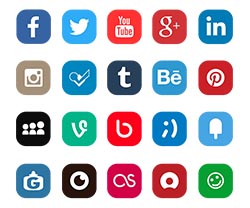 There are so many social networks and online communities! How do you choose which ones to focus your limited time and energy on? Honestly, I don't really have a good answer to that question right now. My specialty has always been search engine optimization. I've never been very good with social networks, but I'm trying my best to learn and continue to build up Travel is Life's social presence. Here's a look at my syndication and social line-up.
There are so many social networks and online communities! How do you choose which ones to focus your limited time and energy on? Honestly, I don't really have a good answer to that question right now. My specialty has always been search engine optimization. I've never been very good with social networks, but I'm trying my best to learn and continue to build up Travel is Life's social presence. Here's a look at my syndication and social line-up.
- Instagram – I mostly post travel photos and my weekly Travel is Life Video since all my videos are less than 60 seconds long. Very rarely do I promote blog posts to Instagram. After all, give the people what they want! And on Instagram we all just want cool pictures and videos.
- Facebook – This is my primary place to post new blog posts, website updates, share videos and photos, interact with travelers I meet, engage with other website owners, and share other people's content. Facebook is more versatile than Instagram in that you can share clickable links to blog posts, which I've got a lot of. I'm also active in many travel groups on Facebook where I'll occasionally share relevant content that adds value to that specific group.
- Twitter – This is my secondary place to post new blog posts and interact with other travelers. I share similar content on my Twitter as I do on my Facebook – only in a shorter format because I have no choice. Twitter is hard for me because I'm verbose. Historically for other projects, it's been a great platform for engaging with other writers and sharing blog content.
- Google+ – If you've ever thought to yourself, “Who still uses Google Plus?”, then I'm right there with you. It's a social platform that never really caught on and Google has since backpeddled from centering your Google Account around your Google Plus Profile. I don't use the platform personally, I'm not part of any groups, and I rarely interact with other writers or brands there. Everyone who's on Google+ is also on Twitter or Facebook (and are usually more active). To be honest, I maintain a presence on Google+ for Travel is Life because it's one more place for Google to index my blog post URLs.
- Tumblr – Other than posting new blog content on Tumblr, I don't do much else with it. I understand that it's a platform that provides the most ROI if you engage with the users. But there's only so much time in the day. For now I use Tumblr similar to Google+, as one more place to post new content and have my blog post URLs linked back to my site from high PR sites.
- Pinterest – Personally I love Pinterest. I think it's a great discovery platform. I have boards created for each of my categories on the site. In the near future, I'm also going to use it to curate my lists of travel brands, favorite travel blogs, and basically things other than just posting my new Travel is Life blog posts. I want my boards to be filled with great travel info and not just used a self-promotion billboards for my site. In my experience, this type of Pinterest strategy will build the most users and inevitably drive the most traffic to my site.
- StumbleUpon – Did you know that StumbleUpon is still an actively used content discovery network with a PR of 8/10? I think StumbleUpon is fun, and it only takes a few extra minutes to post my new blog posts to the network, so I always do. Similar to Google+ and Tumblr, it's one more highly ranked and regularly indexed website to share my links on for search engines recognize my site in more places.
- YouTube – I'm posting my weekly Travel is Life Videos (30-60 seconds) on my YouTube Channel and also on my Facebook, Instagram, Twitter, and Vimeo. From there I'm sharing the YouTube version of my videos on Tumblr and Pinterest. I also use the YouTube version of the video to embed the videos on this website. I don't have much time for video creation at the moment, so I'm sticking to a schedule of publishing weekly short 30-60 second videos highlighting interesting, funny, or amazing viral travel videos. Time permitting, I would like to create 1-2 minute video versions of my Travel Buyer Guides because I think that would be an effective way to consume the content as a viewer. Video is powerful. The more ways I can use video in 2017 on Travel is Life, the better.
- Vimeo – Basically a replica of my YouTube Channel so I don't miss any potential audience on Vimeo. I'm not too experienced with Vimeo as a viewer or a publisher so it's an experiment that I exist on the platform at all. This year will be the test.
What am I missing? What are you doing right with social media that I'm doing wrong? Maybe I'm not doing anything wrong but can improve upon certain areas. Please advise in the comments.
What other plugins do you use on Travel is Life that you haven't mentioned yet?
I use the WP User Avatar plugin by Flipper Code so that I can display custom images for my Authors. By default, WordPress only displays user images if their e-mail address is associated with a Gravatar. But for my Guestbook, I house those posts under a separate author named “Guestbook”. I didn't feel like creating a separate e-mail address for Guestbook and registering it at Gravatar, so I just installed that plugin and uploaded an image.
I use the Customize Login Image plugin by Apasionados del Marketing so that when users visit my login page, they see my logo instead of the default WordPress logo. It's a minor detail that I feel is important. You and I know what WordPress is but not every website visitor does. I don't want them to think, “What's WordPress? I thought I was logging into Travel is Life?” and leave the page.
I use the Bloom plugin by Elegant Themes for populating some of my e-mail signup forms. I own Lifetime Access to all of Elegant Themes themes and plugins so it made sense to use a plugin that worked nice with my Extra theme, and that's already paid for. There are a few limitations of Bloom but I've worked around them and it seems to work great.
What else do I need to know about writing a travel blog?
LOL – I'll tell you when I know! This is a new venture for me, but one that I'm very passionate about and excited to work on every day. As I continue to learn about travel blogging and creating a business in the travel industry, I will update this post and add new related posts to the blog. Be sure to follow along! Sign up for the Travel is Life Friends newsletter.
What'd you think of this post?
Coming in strong at over 7,500 words! I tried to jam pack this post full of valuable information for travel bloggers. Please tell me what you think in the comments section below. All questions, suggestions, and advice is welcome. If your message is private, you can use the contact page or e-mail [email protected].
Happy Travels!
Love,
PAUL

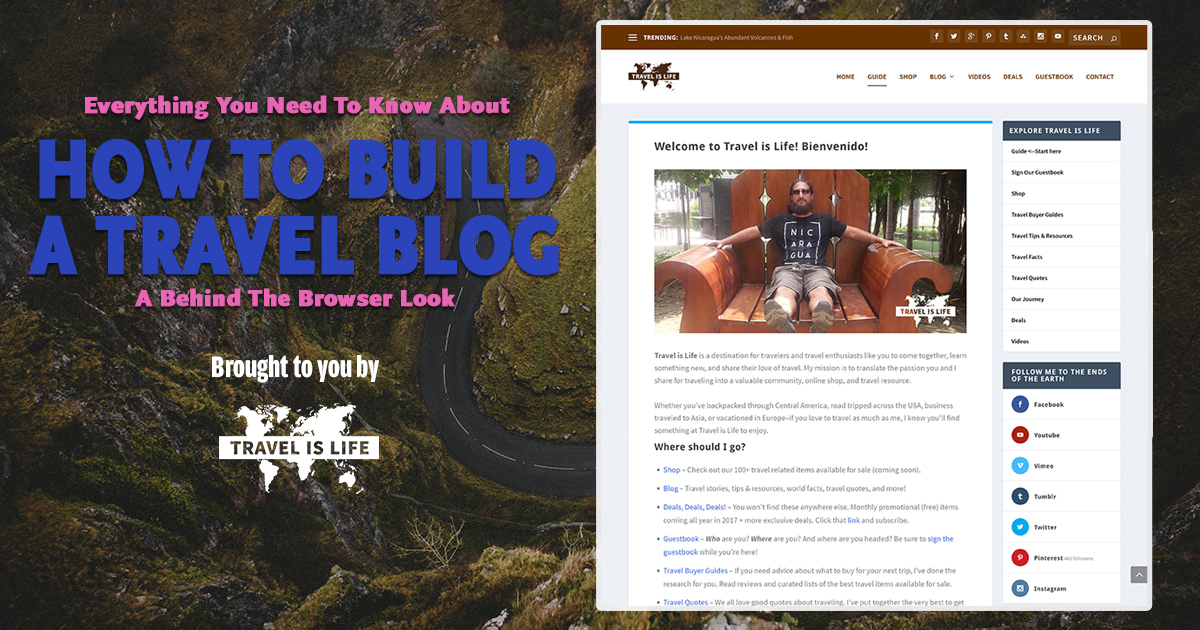
0 Comments